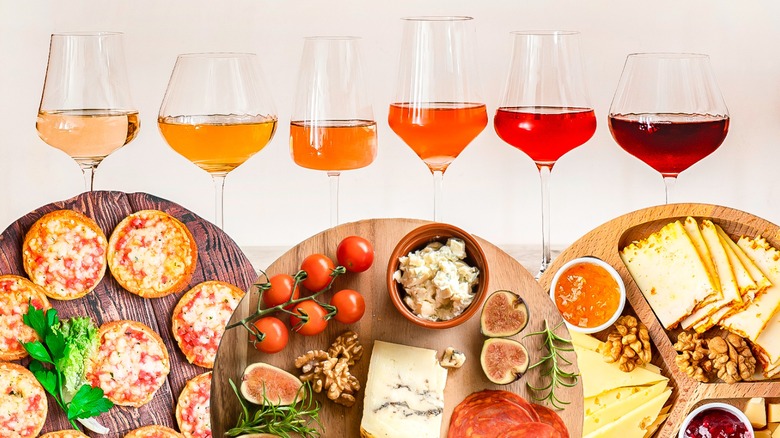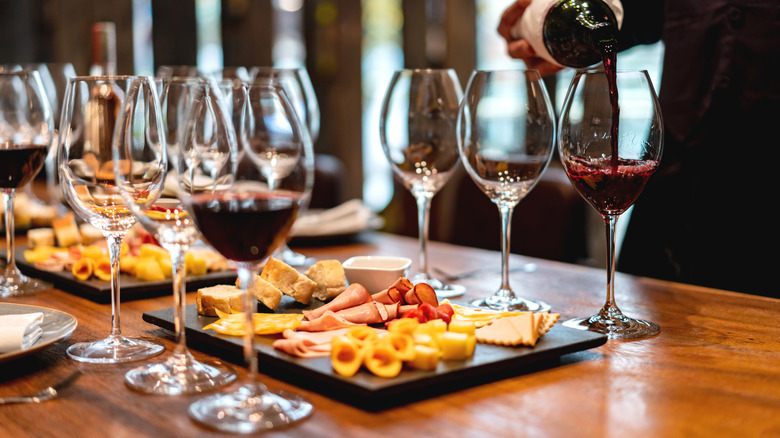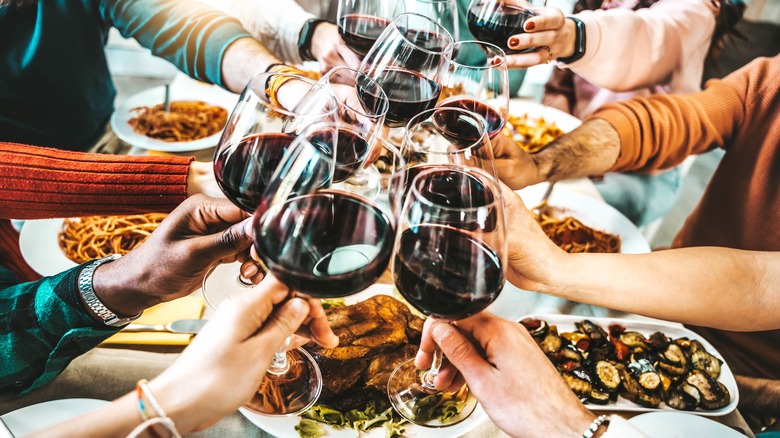When Offering Food At A Wine-Tasting Party, Keep Your Options Light And Simple
Wines are often characterized by the same descriptors as foods, such as acidity, sweetness, mouthfeel, and bitterness. When hosting the ultimate wine-tasting party, your wine selection should encompass the full kaleidoscope of these sensory aspects — and so should the foods you serve with them. Your bites should fill guests' bellies and complement the star of the show. The snacks can be bold but bold in a way that doesn't overpower the wine's flavor profile.
For a smooth party that runs itself, opt for simple appetizers that guests can graze on throughout the night, utensil-free. A charcuterie board is a great wine-tasting snack option for a reason. It makes for stress-free entertaining and hardly any dirty dishes to wash at the end of the night. You can load that board with the entire gamut of tastes to bring out unique notes in the wines you're tasting.
Funky-umami soppressata, fig jam, salty seedy crackers, and olives are just a few ideas. Honey, pickled asparagus, grapes, nuts, sun-dried tomatoes, a variety of cheeses, dried fruit, capicola, calabrese, and dark chocolate squares are all fair game, too. Some spreads like red pepper jam or onion jelly pack two flavors at once for a complex, highly customizable bite. If you're serving port wines, you could even set out a colorful dessert charcuterie board with biscotti and madeleines.
Make sure the vino stays at the focal point
If serving up a spread of appetizers is more your style than arranging an elaborate charcuterie board, keep it simple to let the wine shine. You are, after all, hosting a wine-tasting party, not an appetizer party. Tailor your food's flavors to complement the existing profiles of the wine.
For a bright starter, you could pair Albariño with slices of prosciutto-wrapped cantaloupe or have rosé with strawberry and goat cheese tartlets. Want it darker? Pair Pinot Grigio with a slab of burrata topped with peaches and plums, or Cabernet Sauvignon with beet tartare crostini. Sauvignon Blanc goes great with seafood-forward bites like crab cakes or caviar-deviled eggs. Moscato makes a natural fit with tortilla chips and any kind of fresh salsa, whether it contains sweet ingredients like peaches or something spicy such as jalapeños.
Pair Prosecco with pimento cheese dip, or for a more substantial snack, whip up a thin-crust pizza with white sauce, arugula, red peppers, oven-roasted garlic, and crumbled sausage. Dry chardonnay complements a crusty butternut squash tart or savory cheddar chive scones. Zinfandel goes well with chicken liver pâté or sauteed mushrooms. Or, to lighten things up, you could pair sweet white Riesling with a slab of focaccia topped with creme fraiche, apricots, and basil.
Feel free to creative, but take care not to overdo it
You could also determine your appetizer menu based on a central theme for the night. Maybe your theme is geography. If you're only serving wines from a particular region, you could take a cue from the locals and pair your vino with a selection of foods from that region. For instance, if you were serving only Piedmont wines, you might serve a full-bodied Nebiolo with Piedmont-snack staples like roasted chestnuts or Salsiccia di Bra, and a bright, citrusy Cortese with nutty montebore cheese or sharp, strong DOP Castelmagno cheese.
A standard bottle of wine holds 10 to 12 tasting servings, each of which is about 2 ounces. If you're inviting 10 guests, one bottle per type of wine will get the job done. From there, the rest is up to you to decide. Ultimately, to let the flavor of the vino shine at your next wine-tasting party, set out a few types of crackers and cheeses during the tasting and save any hors d'oeuvres or meal till afterward. Be sure to include a mix of cheeses ranging from hard (comté, cheddar) to semi-hard (manchego, gruyère) to soft (goat cheese, Roquefort) to keep it interesting. You could even whip up some mild gougères to flex a little home-cook flair.


